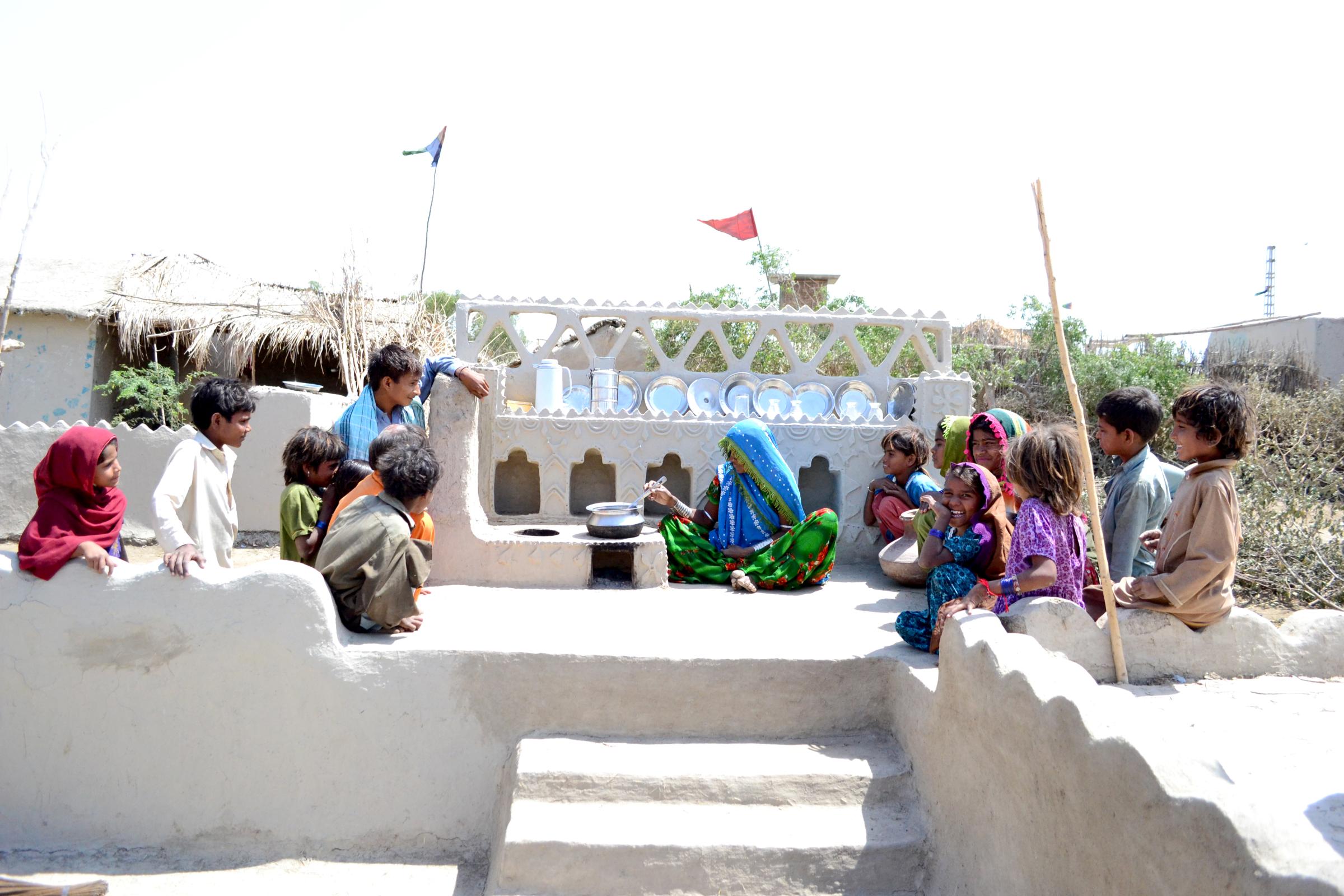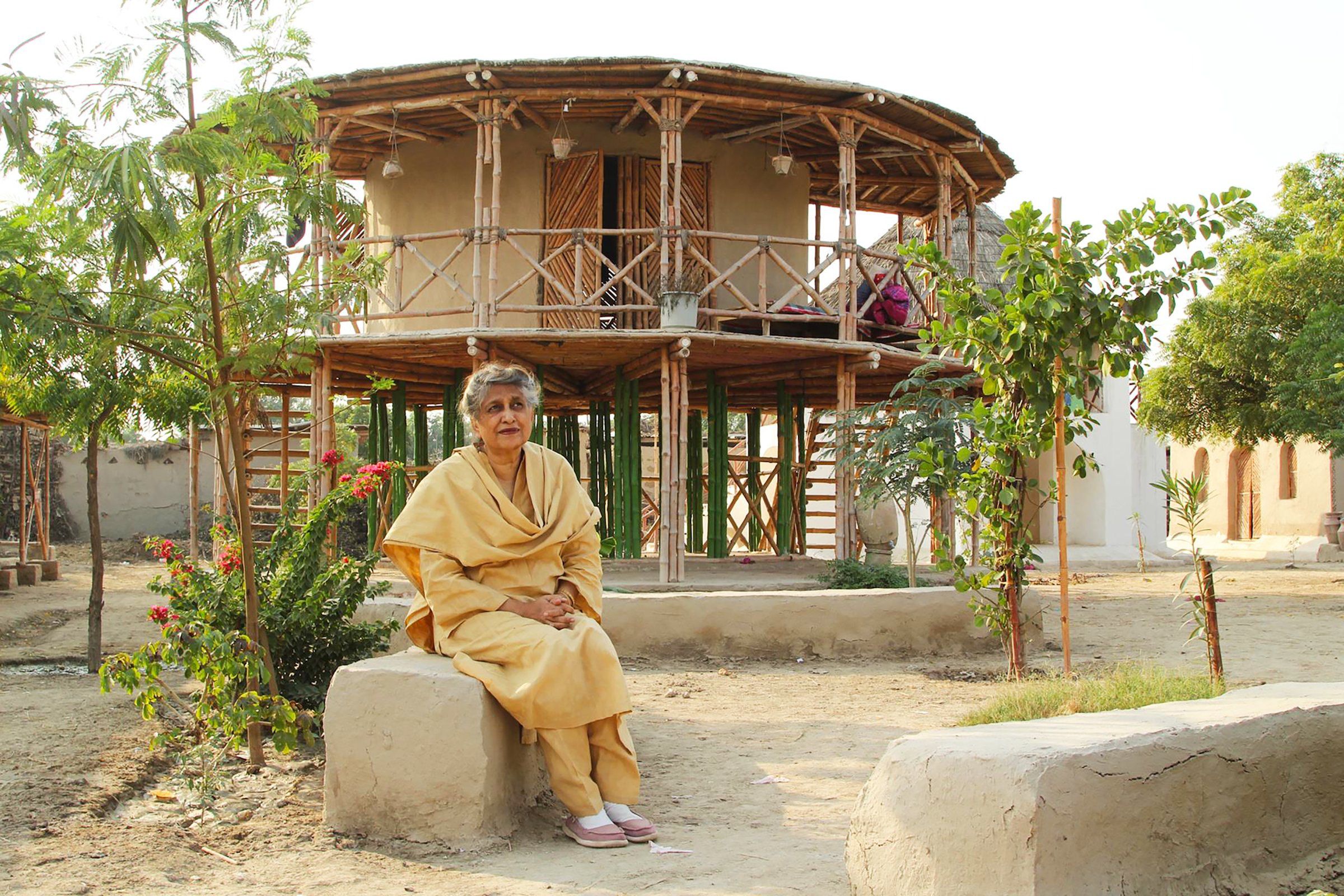Pakistan is home to one of the ancient world’s most impressive examples of flood-resilient design. The ruins of Mohenjo-Daro, a bronze age city in the southeastern province of Sindh, sit on raised platforms with sophisticated drainage systems that protected them from annual monsoon rains. Those features have helped the remains of these earthen buildings survive for 4,500 years—and weather the devastating floods that have repeatedly struck Pakistan over the last decade, most recently submerging a third of the country in August 2022.
And yet, according to Pakistani architect Yasmeeen Lari, those tasked with rebuilding the country from the floods tend to look not to Mohenjo-Daro, but to the West. “I call it the international colonial charity model: international NGOs and UN agencies say, ‘let’s bring in concrete, let’s bring burnt brick’,” she says. “Well, those are alien materials for people in these areas.”
Lari, a slight, energetic 82-year-old who was Pakistan’s first certified female architect, is on a mission to transform how her country rebuilds from natural disasters. In the past, when floods or earthquakes have destroyed homes, aid agencies have rushed to replace them with expensive concrete or burnt brick structures, believing, per the International Organization for Migration, that they were the only durable option. But these are not miracle materials. They are not immune to collapsing under the increasingly heavy rains Pakistan faces, as thousands of buildings did during the most recent floods, and when they do they can crush residents. Concrete also absorbs a lot of heat, making life inside homes tough during Pakistan’s summers, and it’s hard for poorer villagers to maintain or expand on them once construction crews have departed. And, because manufacturing concrete and burnt brick is extremely carbon-intensive, these materials worsen the greenhouse effect that is driving more catastrophic floods in the first place. (The manufacture of building materials makes up 11% of global greenhouse emissions, with the lion’s share coming from concrete.)
A better solution for Pakistan’s climate woes, Lari says, lies in its local architectural traditions. “There is no reason for us not to follow what is already there,” she says, sitting in a cafe at the U.K.’s Cambridge University, where she is lecturing for the year. “You have to design according to the conditions where you are.”
The Heritage Foundation of Pakistan, founded by Lari in 1980, is training villagers in Sindh province to build their own flood-resilient homes from cheap, locally available, low-carbon materials. Lari’s designs use bamboo panels, which are reinforced with earth and lime, and sit on raised platforms—small twists on traditional mud huts that make them waterproof. Once they have the skills, residents can expand their villages and train others. Between mid-September and the end of 2022, the foundation helped build 3,500 homes in 60 villages. Now, Lari is trying to persuade NGOs, banks, and foreign donors to directly fund her trained artisans and local communities, with the aim of building one million homes by 2024.

The timing is urgent. Pakistan is about to launch into one of its most intense periods of rebuilding in its history. Authorities say at least two million people are in need of shelter. And money is on the way: in January, a group of banks and countries pledged some $9 billion in recovery funds.
If those resources are channeled into millions of concrete homes, built without the participation of the people who will live in them, Lari says, Pakistan will only continue in its cycle of crisis. “We have to be talking about: How will you deal with the next disaster? How do we train people to be able to defend themselves?
Read More: Pakistan Flooding Raises Tough Questions About Who Should Pay For Catastrophic Climate Impacts
Lari was not always a champion of Pakistan’s vernacular architecture. When she began her career in Karachi in the 1960s, elites in a newly independent Pakistan were still deeply influenced by British colonialism. Lari had just graduated from the U.K.’s Oxford Brookes University, and her father had been a civil servant in the colonial government. “We grew up thinking that whatever was in the West was something that we all had to emulate,” she says.
Lari spent her first four decades as an architect designing in the western-influenced, globalized palate of concrete, steel, and glass. And she was good at it. Her striking brutalist homes and hotels and other structures won a slew of national and international awards. Her most famous building is probably the headquarters for Pakistan’s state-owned oil company, a sleek, imposing, carbon-intensive behemoth that opened in downtown Karachi in 1991. “The 1980s were a very wasteful time—you could get any material in the world that you wanted,” she says. “And as a designer you do enjoy that freedom.”
She gave up that kind of freedom in 2005. That year, a magnitude 7.6 earthquake struck Pakistan-administered Kashmir, killing a staggering 79,000 people in the region. The quake also collapsed 32,000 buildings and displaced 400,000 people. Lari, who was by then working in heritage conservation, went to help rebuild. Struck by the incredible volume of debris, she determined to use recycled materials wherever possible in her shelters.
Since then, once-in-a-generation natural disasters have struck Pakistan every few years. In 2010, glacier melt combined with heavy monsoon rains swept through towns and villages along the entire length of the country, leaving 14 million without homes. Similar floods happened again the following year, and the year after that.
That cycle is only likely to get worse thanks to climate change. That’s why, Lari says, Pakistan should strive to limit the carbon footprint of its buildings—even though the country bears far less responsibility for rising global temperatures than wealthier countries. (Pakistan is home to 2.8% of the world’s population, but has contributed just 0.3% of global carbon dioxide emissions since the Industrial Revolution.) “In 2005, we built 400,000 units, mostly with concrete blocks, and then it was only five years later that we had the glaciers melting,” Lari says. “So maybe in the global emissions table, we are not that high. But I think we did hurt our own selves in some way.”
Local materials and designs are likely to be more popular in this round of rebuilding than after the 2010 floods, says Shafqat Munir, director of resilient development at Islamabad’s Sustainable Development Policy Institute. That’s in part because of who is leading the programs. Following a 2013 law change, hundreds of international NGOs that were operating in Pakistan a decade ago have departed, leaving Pakistani charities and local initiatives to take a bigger role. “Local charities will tend to use local materials, simply because concrete is too costly.”
But Munir cautions that vernacular traditions need to be adapted to Pakistan’s new climate, in which flood waters linger for much longer than in the past. That means the use of raised platforms—like those found in Mohenjo-Daro—should be greatly expanded, he says, and new technologies, like heat-resistant roofing materials, should be incorporated where available. Guidance from skilled designers like Lari will help: to water-proof earth buildings, Lari adapted a method of slaking lime that is popular in conservation work to make materials more portable.

Lari doesn’t just want to change the building materials people use, but the entire post-disaster charity system. At the Heritage Foundation of Pakistan’s two training centers in Sindh—one near Makli, an archaeological site, and one in the village of Pono Markaz—a team of 10 certified artisans teaches laborers to reinforce earth, build bamboo panels, assemble them into octagon-shaped shelters, and add a roof. Those artisans then travel to villages to teach residents how to build in three-day sessions. Once residents can build a one-room bamboo shelter, they can use earth and lime to turn them into permanent homes, personalize them with outerwall decorations, and learn to build larger versions of the structure for schools or meeting places. Then, Lari says, villages can connect with other nearby communities to train them to build the shelters too. The Heritage Foundation also arranges training sessions for villagers to learn how to make cooking stoves, terracotta tiles, woven matts, and more, with the aim of giving people skills and products to trade with nearby communities. “It is all about knowledge sharing,” Lari says. “Then it can spread massively.”
Prior to last summer’s floods, Lari’s team had helped build 950 homes in Sindh, using prefab bamboo panels assembled onsite, as well as other larger structures at Pono Markaz village. She says the Heritage Foundation surveyed the structures, some of which were left in standing water for two months following the floods, and found no structural damage.

Lari says it costs the foundation less than $200 to build each shelter, with the money going to buy materials and pay the trainers for their work. It also provides funds for villages to set up committees, led by local women, to invest in their micro-industries. (That is compared to about $1,000 to $1,600 for the average burnt brick shelter, and even more for concrete.)
Going forward, Lari wants the foundation’s role to be purely training-based, and for donors to send their money directly to village committees. Such a system, she argues, empowers people to take ownership of the rebuilding process. It would be more efficient and less vulnerable to corruption—a problem that many in the sector are concerned about following a series of massive graft scandals at Pakistani NGOs following the 2010 floods.
It’s unclear, however, if those funding Pakistan’s rebuilding will be receptive to that local-led approach. An initial flurry of interest from donors when Lari proposed her target of one million shelters by 2024 died down, she says, after the World Bank and other development banks announced a large set of grants and loans in January. “There is no longer emphasis on self reliance or empowerment, the emphasis is only on building a shelter,” she says. “If past trends are to be relied upon, the World Bank will be pushing for concrete structures.”
Still, several international development organizations, including U.N. Habitat, Rotary International, Rizq Foundation, and Islamic Relief, are in talks with the Heritage Foundation about how to apply Lari’s model. And smaller local NGOs, as Munir says, may well favor cheaper local materials.
Lari hopes their work will convince others to rethink rebuilding—both in Pakistan and in many other developing countries now facing unrelenting climate disasters. “I really believe that this is the moment to bring about a whole change in the social system,” she says. ”Climate change shouldn’t be taken only as a threat. If we start doing the right thing, it can really transform lives.”
More Must-Reads from TIME
- Cybersecurity Experts Are Sounding the Alarm on DOGE
- Meet the 2025 Women of the Year
- The Harsh Truth About Disability Inclusion
- Why Do More Young Adults Have Cancer?
- Colman Domingo Leads With Radical Love
- How to Get Better at Doing Things Alone
- Michelle Zauner Stares Down the Darkness
Write to Ciara Nugent at ciara.nugent@time.com
